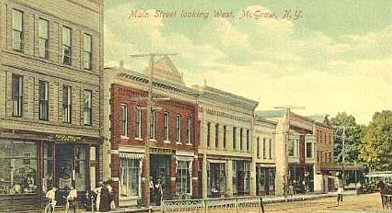HISTORY

In 1809, Samuel McGraw moved to the site of McGrawville (which was named for him) where he purchased 200 acres. At that time there were but three families in the vicinity of the McGrawville village. Mr. McGraw died in February 1836. McGrawville was shortened to McGraw in 1932.
The first school in McGrawville was held in a log house located near the current Presbyterian church. Date is not known, but thought to be in the early 1820's. As the village grew in population, a new framed schoolhouse was built on the corner of South and Center Streets. In 1846 the two schools were combined and moved into a new schoolhouse on Church Street, later to become the Grange Hall.
In 1848, construction started on the Free Mission College. The building committee acquired 167 acres of land for a total cost of $6500.00. This was to be an institution of higher learning, which would be available to any Christian regardless of race, color, religion, or economic background. The name was later changed to The New York Central College because people were traveling great distances to enroll thinking that this meant a free education. It was founded with the radical idea of offering education to both male and female students, black and white. Three black professors were hired as part of the teaching staff. Young men and women were taught together in the same classrooms, studying the same subjects such as languages, math, and science.
In considering locations for the institution, the Board of Trustees decided that McGrawville was a more suitable place than Perry, NY. The knowledge that a direct route of the Underground Railroad into Canada followed the Tioughnioga Valley may have added weight to their decision because soon after the college opened, an underground "station" was operated on the college grounds. The college was located on West Academy Street where the current high school stands and was known as "a beacon on the hill." There was an elemetnary class held on the grounds of the college, but records indicate that the Church Street school continued to hold classes until the Union Free School was established.
By September 1849, the main college building was ready to receive the faculty and 20 registered students. The tuition was $30 a year. The male students paid $5.00 a year for room, and the female students paid $3.00. Both men and women had to pay $1 a week for board at the college. Any student could obtain board at a private home for a $1.25 a week. By 1850, there were 110 students enrolled. In May of that year, smallpox broke out among the students. Some of the Negro students succumbed to this disease and were buried in a small plot of land located on the hill south of the college. The headstones designating the final resting place of these young men are the only markers on the old New York Central College.
In the early 1860's the college was forced to close due to a variety of challenges. The property was sold to stockholders and the remaining college building became the home for the New York Central Academy & Commercial College. This school operated until 1867 when it became the Union Free School. The old Church Street building was sold, the old college building purchased and used for the new "public" school. The first athletic event was held in 1920.
The Union school was within walking distance for the village students, however, students living in the country also needed an education. One room country schools were built to serve farm families in areas outside the village, drawing children who lived one to two miles away from a schoolhouse with classes from first to sixth grade, held in one room with one teacher.
The Union Free School building was deteriorating and in 1928, construction began on a new high school building located on the same lot as the old school. Considerable debate and effort had been made to build the new school on what is now the Purchas Recreation Park on Clinton Street. The location was decided by public vote; the old building was demolished and the present day school building was erected on the site of the old college.
For many years the one room schools continuted to operate for grades one through six, with upper classes consolidated into the McGraw High School. In 1950 a plan for centralization was presented, plans for improvement of the 1928 building voted on and approved. Construction began in 1952.
By the 1960's the elementary classes outgrew their classrooms in the high school building. Classes were divided up and school was held at the village library, the fire station, and in two buildings owned by a local resident. A new elementary school was built on West Academy Street that opened in the fall of 1967.
If you would like any further information on the history of McGraw, please visit the Lamont Free Library located on Main Street in McGraw. The friendly staff there will be glad to assist you.
Thank you to Mrs. Mary Kimberly, Villiage of McGraw Historian, for updates to this page.


